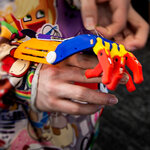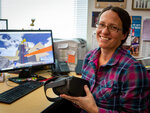

During his twelve years in the Cascade School District, senior Kelvin Ramos has needed assistance to open doors. From his wheelchair, the door-opening buttons have always been several inches beyond his reach.
Now, using the 3D printer in the Life Skills class at Cascade High School, Ramos is in the process of designing the perfect assistive device. Along with teachers Jessi Klancke and Jamie Krejci, Ramos is making a plastic dowel holder that will Velcro to the back of a glove. Krejci made a prototype that needs some adjustments, but eventually Ramos will be able to reach down, snap on the dowel and open doors himself.
Ramos will be free to come and go as he wishes, and can take his assistive device anywhere, including to college next year.
This couldn’t have been possible if Klancke, the Life Skills teacher at Cascade, hadn’t thought outside the box for the sake of her students. But 3D printers are expensive. “Last year when a teacher wasn't hired for the CTE position, I offered to take the 3D printer that wasn't being used at the time and utilize it in my classroom,” said Klancke. When the printer was needed in the new CTE class, she knew she needed a replacement.
“We approached a few organizations to see if we could find some funds to buy our own 3D printer. Projekt Bayern, the Peshastin Gun Club and the Taffy Shop all contributed. Without their grants, we couldn't have purchased the printer ourselves.”
The spools of colorful plastic filament, which get fed into the printer, are relatively inexpensive. Now a whole new world has opened up for the students who are based out of the Resource room and Life Skills classroom, and also for those who spend just an hour each day there.
The very first object Klancke and the students created was a red dog. They utilized free designs found on the website, thingiverse.com.
That sounds simple, but teachers and students went through a learning curve together. For instance, since the objects are built from the bottom up, an object with an overhang will fail unless you add thin supports that can be snapped off after the printing is complete. They have also learned to check exactly how long each printing will take, because complex designs can take almost a day. They can reduce the time and materials by lowering the percentage of infill, so that inside the object is a honeycombed structure instead of solid plastic.
When things don’t go right, the gnarled plastic scrapes are thrown into a small bin labeled with a quote, “We learn from failure, not from success.” This is part of Klancke’s philosophy, that the process of troubleshooting is just as important as the goal of creation.
Sophomore Collin Stitt knows the printer as well as Klancke. Last year, he worked on a technical project, in which he printed the parts for a prosthetic hand, even down to the screws. After printing he had to assemble it using wires and strings and adjusted the tension to open and close the fingers.
Students are limited primarily by their imaginations. Some of their recent creations include Christmas ornaments for Projekt Bayern’s Christkindlmarkt, cookie cutters, masks, phone holders, and a statue for a miniature Dia del los Muertos ofrenda.
The next step that some students are taking is using the program tinkercad.com to design their own objects. Students improve abstract and spatial thinking skills in the process, useful for a variety of tech jobs.
For Klancke, there’s a strong personal connection to designing functional things with her students. “My dad was a plastic tooling engineer for almost fifty years,” she said. “He lost his battle with cancer two years ago, and I miss the connection we shared over making things. I know nothing about engineering or programming; I literally stumbled over every step getting the 3D printer running. But when the printer finally began to print, I felt like I had a little piece of my dad back. I know he would be so proud of what we're doing.”
Working in the special services classrooms requires collaboration. Klancke worked closely with colleague and friend, Erin Hagedorn, who passed away last summer. Klancke and the students who miss Hagedorn’s presence are channeling some of their heartache into these 3D printer projects, which was fully supported by Hagedorn.
Another avenue for these students to explore is through virtual reality (VR). Klancke has grown her collection of inexpensive VR goggles and one Oculus with more capabilities. The students use the goggles to interact with a VR world built with blocksmith.com. Klancke hopes that some students will design elements of a VR world for other students to explore creatively.
Comments
No comments on this item Please log in to comment by clicking here